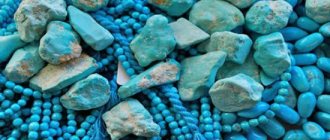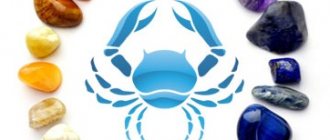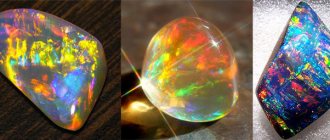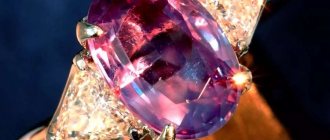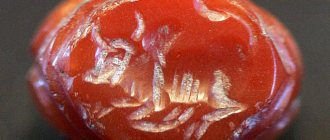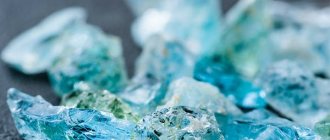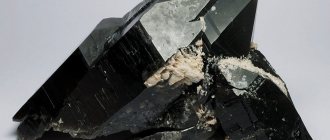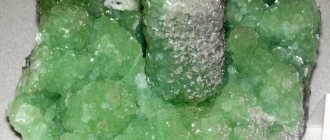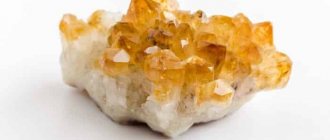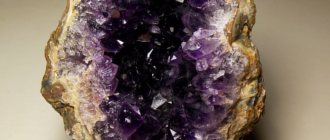Physical and chemical properties
Alexandrite
Alexandrite belongs to the chrysoberyl group. The special structure of the crystal lattice and the location of trivalent chromium ions in it as an impurity determine the presence of a unique optical effect in the mineral.
Under artificial and natural lighting, light rays are reflected differently as they pass through the crystal. This is why it appears blue-green during the day and purple-red in the evening - an alexandrite color reverse.
The mineral melts at a temperature of 1800 degrees, is resistant to acids, except hydrofluoric and boric acid, and is unstable to alkalis.
| Formula | Al2BeO4 |
| Color | Changes from emerald green to purple red |
| Probable impurities | Chrome, titanium, iron, vanadium |
| Shine | Glass |
| Hardness | 8,5 |
| Transparency | Transparent or translucent |
| Strength | Lasting |
| Kink | Conchoidal |
| Cleavage | Imperfect |
| Density | 3.5-3.84 g/cm3 |
| singonia | Rhombic |
| Refractive index | 1,744-1,758 |
Basic methods for distinguishing natural alexandrite from synthetic one
- Refractive index
The first and most accessible and correct indicator is the refractive index. The value is dimensionless, which varies in the range 1.745 – 1.754. The refractometry method is based on the refraction of light passing through solid and liquid samples placed between two prisms and is determined using a refractometer. If the refractive index value is outside the given limits, this means that you are looking at an ordinary fake that has nothing in common with a precious sample.
- Stone hardness
Alexandrite is a fairly hard mineral, its hardness on the well-known Mohs hardness scale is about 8.4 - 8.5. It can scratch the glass and, in turn, scratches from the diamond remain on it. Of course, it is harder than glass and ceramic tiles.
- Pleochroism (dichroism)
This phenomenon is observed on a dichroscope or spectroscope. By viewing the mineral from different angles, green, purple and orange colors can be revealed. Other natural minerals either do not have dichroism at all or have different color shades.
It is possible to determine the authenticity of a sample only if all the listed factors are present.
Colors and varieties
Alexandrite raw
Alexandrites are classified according to their color:
- Colored.
- Colorless.
- Digitizers are translucent samples that have a cat's eye effect or asterism.
According to the place of extraction, imperial stones are divided into:
- Ural ones are the most beautiful and expensive. In natural light, Ural alexandrites have a bright and multifaceted blue-green color. Under artificial light, the stones turn raspberry-purple. The color reverse of Russian gems is recognized as the deepest.
- Indian or from Sri Lanka . The transitions of their colors are smoother and less deep. During the day, the samples are greenish-blue, in the evening they are blue-violet with a slight reddish tint.
- African and Brazilian . In daylight, such alexandrites have a brown-green color; under lamps they reveal a reddish tint.
Ural stone alexandrite
Artificial alexandrite
Attempts to create artificial alexandrite have been ongoing since the second half of the 20th century. Some experiments turned out to be successful:
- Czochralski alexandrites were first grown in Novosibirsk. Crystallization was carried out at temperatures above 2500 Kelvin. In just a week, scientists managed to obtain alexandrite “icicles” up to 12 centimeters long and up to 3 centimeters in diameter.
- The American Bell Laboratory synthesized alexandrites by polarizing molten salts. Their crystals were up to 4 centimeters long.
- Sometimes artificial corundum grown in a Verneuil furnace is passed off as alexandrite. The resemblance to the imperial stone is given by the oxides of aluminum and vanadium in the composition.
Synthetic alexandrite
Synthetic gems may also be beautiful, but they do not have healing or magical potential.
The magical properties of alexandrite
Only Indians know for certain about the magical capabilities of alexandrite, since the gem has been known to them for a very long time. The first mention of it was found in the ancient Indian epic “Mahabharata”. The author, describing the stone, calls it a “peacock's eye.” In India, alexandrite is still considered a protector of the family, a giver of prosperity and prosperity. It is also worn to gain wisdom and in moments of difficulty to find the most correct solution.
This is interesting!
In 1967, the crime comedy film Fantômas premiered on Soviet screens with Louis de Fines in the role of an unlucky policeman. Few people know that the story is based on real events. The prototype of Fantômas is a German count who lived several decades before the film adaptation. At some point a crisis came in his life. The Count went to India to find a solution. There he became an apprentice to a major astrogemmologist. Upon returning, the count moved to live from Germany to France. There he began robbing large jewelry stores. The French police knew everything about the count, but could not catch him by the hand and prove his guilt. Fantômas was helped to remain invisible and elusive by alexandrite, brought from India, which was always in his pocket.
Thus, the most invaluable magical property of alexandrite is to grant its owner invulnerability to various kinds of dangers. The stone warns of impending trouble by revealing a golden-brownish sheen. He averts misfortune and repels the attacks of enemies.
Alexandrite ring
Alexandrite also enhances its owner’s intuition and tells him about future events, for example, through dreams. For this property, the gem is called a “prophet”.
Modern European esotericists interpret the color of the stone in their own way. They believe that green shades symbolize jealousy and unrequited feelings, and purple shades symbolize passion, tenderness and love. Alexandrite truly enhances human emotions, so it must be worn carefully. Cholerics and overly impulsive people should avoid wearing the stone.
In addition, alexandrite:
- Patronizes gambling and risky individuals.
- Makes a person successful and financially independent.
- Develops creativity.
- Helps you achieve goals and fulfill your cherished desires.
- Serves as a source of vitality.
- Improves mood and teaches you to enjoy life.
- Strengthens a person’s inner core and helps to find harmony in the soul.
- Promotes spiritual growth.
Compatibility with zodiac signs and names
The gem is filled with the energy of Earth, Ether, Water; influenced by Mars and Saturn.
Those born under the zodiac signs of Gemini, Scorpio, Aquarius and Leo receive the greatest patronage of the breed. These are people with a strong and complex character, filled with conflicting emotions. Their inner world is in harmony with the magic of the mineral:
- Geminis are fickle and contradictory. Jewelry for them is a way of finding balance, peace, and tranquility in the soul. The stone helps to discover harmony without suppressing curiosity.
- Scorpio is born a fighter. The stone saturates him with energy, allowing him to overcome all obstacles, comprehend insight, and reach a new level of personal development.
- For Leo, the mineral is a talisman of power, attracting success to life.
- Aquarius, using the stone as an amulet, enhances the ability to create. Under the influence of alexandrite, intuition is improved.
Less useful, but not harmful stone: Aries, Libra, Sagittarius, Pisces, Capricorn. If a person born under one of these signs feels uncomfortable while wearing alexandrite jewelry, it is necessary to discard the item.
The jewel is contraindicated for Cancer, Taurus, and Virgo.
The stone patronizes: Sasha, Lyuda, Alice, Lesha.
The gem is useful for Scorpios and Leos
Medicinal properties
Faceted alexandrite
Alexandrite is actively used in stone therapy to get rid of various ailments.
Lithotherapists warn that the stone is most effective during the daytime. And at night, on the contrary, it releases the negativity absorbed during the day. Therefore, at night the stone must be removed.
Alexandrite is used to treat:
- Varicose veins and also cleanse blood vessels.
- Gastrointestinal tract dysfunctions.
- Nervous system – relieve stress, relieve depression, normalize sleep.
- Skin diseases of any nature, including infectious, as well as scabies.
- Malfunctions of the pancreas and thyroid glands.
- Diabetes mellitus in its early stages.
- Osteochondrosis and other diseases of the musculoskeletal system. The stone reduces pain, relieves pinched nerves and facilitates movement.
Alexandrite water is an effective remedy for detoxification. The gem should be placed in water overnight, and in the morning the resulting infusion should be given to an alcohol dependent person to drink on an empty stomach. The stone will reduce cravings for alcohol and cleanse the body of toxins.
Is Alexandrite a widow's stone?
Alexandrite has changed many names. It was called the imperial gem, since the first official owner of the stone was Emperor Alexander II. And the emerald green and purple-red colors of the stone reflected the main royal colors of that time, symbolizing power and luxury. Remembering the great reforms of Alexander II - the abolition of serfdom and others - alexandrite was called the liberator stone and the stone of justice.
In the 45–50s of the 20th century, the gem began to be called the “widow’s stone.” 10 - 15 years before the production of synthetic alexandrite was established. Jewelry with it filled the shelves of jewelry stores. Ladies from Soviet families added to their jewelry collections. And then the Great Patriotic War began, in which many men died.
In the difficult post-war times, women sold their jewelry with alexandrite in order to somehow survive. The public quickly connected two facts - alexandrite and a widow. And the name “widow” firmly clung to the stone. A little later, a sign was invented that alexandrite will not lead to loneliness if you wear jewelry with it in a pair, for example, earrings or a ring with a pendant together.
History and origin
Alexandrite stone is an amazing chameleon, first discovered in 1830. It was named in honor of the future Emperor Alexander II, who was given as a present for his 16th birthday. Now the gem is a symbol of Russian jewelry, but it itself is not sold in Russia. Large, high-quality jewelry samples are extremely rare in nature. Each specimen found is unique and priceless.
It is believed that the discovery of the precious mineral is the merit of the Finnish mineralogist Nils Nordenskiöld. Among Perovsky's samples, the scientist found an unusual stone of rich green color and high hardness. Having not had time to examine it during the day, the mineralogist decided to continue studying in the evening and discovered that when the candles were lit, the sample was painted bright red. The official description of the mineral was compiled in 1842.
An alternative discovery story links the gemstone to the mines on the Tokovaya River. In 1833, Kokovin described an emerald, which was then taken to St. Petersburg for research by Perovsky, who was surprised by the high hardness of the rock. A detailed examination revealed the ability of the gem to change color.
Stone of unusual beauty
Previously, it was believed that alexandrite was a sign that the deposit had run out of emeralds. It’s hard to believe, but this stone was found a long time ago, but was considered worthless, useless, and after two centuries have passed since the discovery of the unique properties of the color of the alexandrite stone, the treasure in our country has been exhausted.
For Alexander II, who received the stone for his 16th birthday, the magical gem became a talisman - the king did not part with it for a minute until the day of his death. On the day of the assassination attempt, he forgot the jewelry and became the victim of a successful attack. So the gem became a sign of grief for the deceased ruler. In Leskov’s novel, the lapidary Wenzel says that during the day the green stone turned red by night, as if filled with blood.
They tried to grow the stone artificially
This is not the end of the tragic connections between the history of the gem and the imperial family. The place where the rare chrysoberyl was first found is located not far from the site chosen by the Bolsheviks for the execution of the reigning family.
At the end of the last century, artificial alexandrites were first mined. The quality turned out to be such that even in the laboratory it was impossible to say for certain whether the sample appeared naturally or was made by man. The first batch, without being certified as synthetic, immediately went on sale. It is not possible to identify those specimens - they are forever mixed with the real ones. Nowadays, artificial alexandrite is practically not grown due to the high cost of the process. Experimental laboratories were created in Russia, but they are all closed.
Products and jewelry made of alexandrite
Alexandrite pendant
Alexandrite is a real treasure, as it has an unearthly beauty, and is rarely born in nature. This has to do with how the stone is formed. In greisen and pegmatites, at special temperatures and humidity levels, a chemical reaction occurs between beryllium and chromium. A prerequisite is the absence of silicon, which is extremely rare. For these reasons, there are few alexandrite deposits on Earth and the cost of mined stones invariably remains at the highest level.
The best examples, as a rule, go from auctions to private collections or become the property of museums. Simpler stones (less bright and with defects) go to the rest of those who wish.
This is interesting!
The Smithsonian alexandrite weighing 65.08 carats is considered the most valuable and rarest today. The largest gem is shrouded in mystery. It is certified by the State Corporation of Precious Stones and registered in the Guinness Book of Records as a stone weighing 141.92 carats. Besides this, all that is known about this alexandrite is that it is the property of a private Japanese collector. According to rumors, the stone was purchased for more than one hundred million dollars.
According to the English magazine GemGuide News and Analysis, the cost of natural alexandrites directly depends on their quality:
- Excellent – 17-22 thousand dollars per carat.
- Very good – 9-12.5 thousand dollars per carat.
- Good – 3.5-6.5 thousand dollars per carat.
- Low – 600-2.5 thousand dollars per carat.
Gold earrings with alexandrite
These prices are indicative only. Each found alexandrite is assessed individually, taking into account the deposit, color saturation, reverse depth, weight, and the presence of defects. For example, a few years ago, a record-breaking alexandrite weighing 21.41 carats, mined in Russia, was sold at Christie's auction in Geneva. Its cost was 1.47 million dollars, that is, almost 70 thousand dollars per carat.
On the official website of the Ural alexandrites you can purchase exclusive products with natural stones. For example, a gold ring with a 0.2 carat insert costs $178, and with a 1.47 carat stone costs $665. The cost of a ring with the same stone (1.40 carats), but of better quality and complemented by 10 small diamonds (0.10 carats), increases to $3,650.
Products with artificial alexandrites are priced much more modestly in online stores. For example, a silver bracelet with 9 fairly large stones will cost only $80.
Advice from astrologers
To whom alexandrite is suitable according to the horoscope, it is worth asking astrology experts.
As a rule, astrologers recommend chrysoberyl to the following zodiac signs:
- Gemini.
- Pisces.
- Aquarius.
- Libra.
- Virgos.
- Aries.
- Leos.
The dual nature of Gemini is symbolized by the crystal's ability to change color. Representatives of this sign will become calmer under the influence of the stone, while alexandrite will enhance the natural energy of Gemini and help cope with fatigue and nervous tension.
For Pisces, the stone will help develop a business; it will become a good amulet, bring success in business and ensure an influx of finance. Jewelry inlaid with the mineral can be worn regularly, but it is better to resort to their help only when concluding a profitable deal.
Emotional Aquarians can use a crystal to improve their character. The stone will make representatives of this sign less hot-tempered and irritable. Gives you wisdom and self-confidence.
For Libras who like to think about pressing problems, the mineral will help cope with daydreaming. It will bring representatives of this sign back to reality and help solve existing problems.
For Virgos, the crystal will bring good luck; it will help get rid of excessive modesty and establish communication with colleagues, relatives, and friends. Also, representatives of this sign, under the influence of alexandrite, will become decisive, gain courage and desire to be the first always and in everything.
For Aries, the stone will help cope with the emotions and feelings that often overwhelm representatives of this sign. Will bring success in business and other endeavors. Alexandrites will also help to reveal talent and realize potential.
If we talk about who chrysoberyl is ideal for, then it is Leo. They are regal and majestic, love power, thirst for victory. The stone will help representatives of this sign achieve success in all their endeavors, make profitable contacts and achieve their desired goals.
Alexandrite has a powerful but complex energy that can make the owner a leader. Or he can subjugate him to his will, force him to do stupid, rash acts.
How to distinguish an original from a fake
Alexandrite Jewelry
It is almost impossible to find real alexandrite in mass-market stores. Only elite jewelry houses sell natural gems and ask a lot for them - this is the first evidence of the authenticity of the stone. Secondly, the weight of natural alexandrites usually does not exceed 3 carats.
Natural alexandrite is a good investment, but in order not to run into scammers, you need to choose a stone in the presence of a professional gemologist. If this is not possible, then before purchasing you should study the properties of natural stone in order to be able to identify a fake.
Naturally occurring Alexandrite always changes color depending on the light. In daylight it is blue-green, in lamp or candlelight it is purple-red. When viewed from different angles, the stone reveals different shades of these colors and also casts yellow highlights. Natural alexandrite is hard and cannot be scratched with a needle. It will remain cool in your hands for a long time.
Cheaper natural and synthetic gems or even glass can be used as imitations of alexandrite. You can find them out like this:
- Imitations made of glass, created by adding nickel and chromium to it, are distinguished by their low hardness. They are easily scratched by a needle. They also don't have a color reverse.
- Artificial alexandrites can be recognized by their large sizes, bright colors and the presence of bubbles of a regular spherical shape.
- Counterfeits made of synthetic spinel, somewhat similar to alexandrite, are distinguished by shades of color. Spinel colors vary from blue to purple rather than green to red. It also doesn't cast yellow highlights at all.
- Corundum imitations become bright yellow under artificial light.
- “Alexandrites” made from andalusite are not characterized by color reverse. Rainbow shades appear when you change the viewing angle; lighting in this case does not play any role.
General information
First of all, let's figure out how a natural mineral differs from an artificial crystal?
From numerous photos you can see that the natural mineral differs from the artificial one in appearance. Usually this is a gem with defects and characteristic stripes. And only after cutting does it acquire its characteristic unique beauty. A synthetic crystal usually contains inclusions in the form of bubbles; the so-called growth lines are clearly visible on it.
Natural alexandrite is one of the rarest varieties of chrysoberyl; its characteristic green color comes from chromium compounds; while artificial alexandrite is obtained by growing crystals from a solution in a melt or, later, by the Czochralski method - pulling crystals from a melt.
How to care for stone
Ring with Ural alexandrite
Alexandrite is a durable and unpretentious stone. He is not afraid of blows, and only a diamond can scratch him. But it is better to store the gem in a personal case. The main danger to the integrity and aesthetics of the stone are alkalis and products containing them. Therefore, when cleaning, washing, washing or cleaning anything with household chemicals, the stone must be removed.
Alexandrite does not need to be cleaned too often. It is enough to rinse the stone with warm running water once every 2-3 months. If there are dirt on it, they need to be removed with a soft brush dipped in a soap solution. Residues of soap must be thoroughly rinsed off and the surface of the stone wiped with a dry soft cloth to avoid streaks. Alexandrite can also be cleaned with ultrasound.
Field
The unique jewel was originally mined in the Urals. This source is the only indigenous one on the planet. It is completely depleted and closed in 1995.
Placer deposits boast:
- Brazil (the field operated in 1987, developed in 3 months);
- Tanzania.
The best examples are Ural gems
The mineral is mined on the islands of Sri Lanka and Madagascar. The quality of specimens from alluvial deposits is noticeably worse than those recovered from primary deposits.
Who suits the name
The name of the stone suggests that it is the patron saint of Alexander and Alexandra. This is true.
Sashas of any gender can count on maximum and comprehensive support from the stone. As long as alexandrite is nearby, its namesakes will be invulnerable both physically and mentally. In addition, they will receive everything they have long dreamed of.
Alexandrite is also happy to help change the lives of Ivans and Yuli, Eva and Evgeniy, Nikolai and Tatiana, Irin and Dmitry for the better.
The magical influence of the stone
The magical properties of the alexandrite stone cannot be overestimated. This is truly a unique gem. He has incredible power in attracting success, wealth, and power. The owner of the stone, if they become friends, will reach unprecedented heights in their career and personal life. But do not forget that this mineral does not respect weak, weak-willed people. Therefore, for him to become a talisman and assistant, you need to be active yourself.
Alexandrite has strong predictive properties. If it has acquired a yellow or brown tint, then you should be more careful - this is how the stone warns the owner of danger.
The legend that alexandrite is a “widow’s stone” is a thing of the past and overgrown with grass, but many mystics believe that the gem brings loneliness. To prevent this from happening, alexandrite should be worn in pairs. For example, you can purchase earrings or a pendant to go with the ring. Then negative magic will not work.
The stone recognizes and respects only a strong personality. Only such a person will he serve faithfully, helping him achieve his goal. It is better for a weak-willed, lazy, weak-willed person not to get involved with this crystal. Otherwise, the owner will not be the owner, but the stone. The magical meaning of the alexandrite stone carries both positive and negative characteristics. Therefore, if you want to become the owner of this precious gem, you must first evaluate your strength.
Compatibility with other minerals
Alexandrite is an expensive pleasure. Jewelers rarely combine it with anything other than diamonds. And energetically, these two kings of gems are ideally compatible. In addition, alexandrite gets along well in jewelry with sapphires and topazes, garnets and citrines. It conflicts with other stones.
Rules for wearing and care
Caring for alexandrite is easy. Basic Rules:
- cleanse from contaminants;
- store in a separate box with soft walls;
- choose cool, dark places for storage;
- avoid chemical care products;
- protect from falls, contact with metal products, stones;
- wash with cool water.
Since jewelry with a gem is rare and expensive, it is not customary to wear it with other jewelry.
Wearing rules:
- combine stone with gold;
- put on jewelry last, take off first;
- more often use rings and rings decorated with the breed, rather than jewelry for the neck and ears.
Stone is picky in choosing neighbors
Designers recommend mono-jewelry. If you really want to wear alexandrite with other stones, choose diamond, garnet, citrine, and topaz as a neighbor. You can combine the rock with amethyst.
